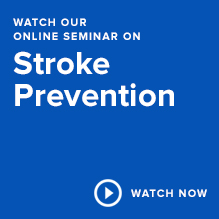Stroke Question and Answer
Jul 6, 2022March 17, 2018
What Is a Stroke?

A stroke occurs when the flow of oxygenated blood to the brain is obstructed. During a stroke, affected brain tissues receive less oxygen, leading to cell damage and possibly death. There are two types of stroke:
- Ischemic stroke occurs when blockage prevents blood-flow within a vessel. Blockage is often the result of a blood clot or similar structure. Atherosclerosis, hypertension, high cholesterol, diabetes and smoking are all risk factors that may increase the likelihood of Ischemic Stroke.
- Hemorrhagic Stroke occurs when a blood vessel breaks, or is ruptured. Ruptures disrupt circulation and increase intracranial pressure, leading to cell death. Hypertension and aneurysm are risk factors that may increase the likelihood of Hemorrhagic Stroke.
What Are the Warning Signs Of a Stroke?
Warning signs for a stroke may include sudden numbness or weakness, confusion, trouble speaking, headache, dizziness, blurred vision, or difficulty walking. The American Stroke Association (ASA) recommends that individuals use the acronym “F.A.S.T.” to identify signs of a stroke and act accordingly.
The “F.A.S.T.” acronym is as follows:
- F – Face Drooping: Individuals suffering a stroke may experience facial numbness. In many circumstances individuals are unable to move both sides of their face.
- A – Arm Weakness: Individuals may experience weakness or tingling in one or both arms.
- S – Speech Difficulty: Individuals may experience difficulty speaking. Words may be slurred, and annunciation may be difficult.
- T – Time: to Call 9-1-1
If an individual exhibits one or more of these symptoms, contact an emergency medical professional.
Can You Prevent a Stroke?
Nearly eighty percent of strokes are preventable. Some risk factors of stroke include:
- High Blood Pressure – the largest predictor of stroke. Proper diet, medication and exercise can help to mediate hypertension.
- Smoking – Nicotine and carbon dioxide have damaging effects on the cardiovascular system.
- Poor Diet – Diets high in saturated fat, trans fat, and sodium have been known to raise cholesterol. Research demonstrates that eating 5 or more servings of fruits and vegetables per day can reduce risk of stroke.
- Diabetes – The presence of diabetes has been linked to higher occurrence of stroke amongst individuals. Individuals with diabetes are also more likely to be overweight, have higher cholesterol and have higher blood pressure.
- Obesity – Being overweight increases one’s chances of heart disease and stroke. The American Heart Association suggests that individuals engage in 30 minutes of vigorous activity daily.
- High Cholesterol – which has been shown to increase instance of stroke, especially in men.
- Atrial Fibrillation – which can lead to poor circulation, pooling of blood in the heart and increased clotting.
While some of the risk factors of stroke can be controlled, others are genetic. Heredity, age and race all influence one’s likelihood of stroke as well.
How Do You Treat Strokes?
Stroke treatment varies depending on the type. For Ischemic Strokes, medical professionals administer a medication known as tissue plasminogen activator, or Altiplase IV r-tPA. This medication, given intravenously, dissolves blood clots so that circulation can continue. Altiplase IV may be effective when used between up to 4 hours following a stroke.
Blood clots responsible for Ischemic Stroke can also be removed through a procedure known as mechanical thrombectomy. During the procedure, surgeons use a wire device known as a stent retriever to remove the clot. The surgery is minimally invasive. Surgeons thread a catheter from the groin to the brain through the arteries. The procedure may be used up to 6 hours after an individual experiences a stroke.
Hemorrhagic Stroke treatments rely on procedures similar to mechanical thrombectomy. The procedure requires a surgeon to thread a catheter through an artery in the arm or leg to the brain, where damage can be repaired.
What Is TIA?
Transient Ischemic Attacks (TIA) are often labeled as “mini strokes.” During TIA, blood flow to the brain is restricted for a short amount of time. Oftentimes, episodes last just a few minutes before a clot is dissolved or dislodged. During the attack, individuals experience symptoms similar to those of a stroke. However, when the clot is dislodged, blood flow returns to normal and there is no long-term damage.
Does TIA Lead to a Stroke?
Though TIA does not lead to long-term damage, research shows that individuals who experience TIA are likely to experience a stroke within the next year. Recent figures estimate that 10.5% of TIA diagnoses lead to a stroke within 3 months and 33% in a year. For this reason, TIA is often referred to as a “warning stroke.”
What Are Treatment and Prevention Options for The Future?
Fortunately, many treatment options exist for those diagnosed with TIA. Doctors may prescribe antiplatelet or anticoagulation medicine, reducing the tendency for blood to clot or clump. Stroke can be prevented through making healthy lifestyle choices. Exercise, proper diet and refraining from drugs and alcohol have all been shown to decrease the chance of stroke.
A great deal of research has been dedicated to finding more effective ways of preventing and predicting strokes.
